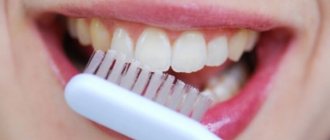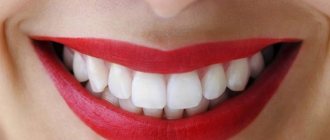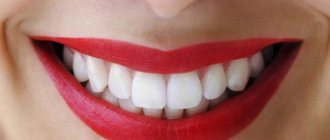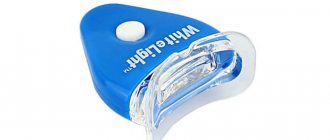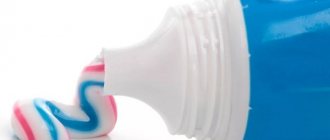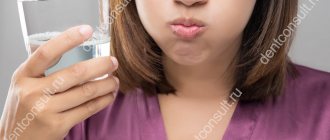How does baking soda affect teeth?
Soda is a good and inexpensive disinfectant. Even now, doctors recommend using it in dental treatment of infants who are diagnosed with stomatitis or oral thrush.
Soda kills fungus and promotes rapid healing of ulcers on the mucous membrane that appear as a result of stomatitis due to its high regenerative properties. In addition, sodium bicarbonate has a pronounced anti-inflammatory effect. Dentists often prescribe rinses or baths with soda or soda-saline solution for purulent periodontitis and pulpitis, after opening the cavity of the affected tooth.
In America, clinical observations of the oral health of patients using soda pastes for brushing their teeth and microbiological analyzes of the contents from the oral cavity of these patients showed that the concentration of pathogenic microorganisms is significantly reduced.
Whitening effect of brushing teeth with baking soda
As for hard tooth tissues, soda has a good whitening effect . The enamel is lightened by at least 0.5 shades, which can be compared with professional oral hygiene. This happens thanks to abrasive particles that efficiently clean the tooth surface from dental plaque and food debris. Conventionally, you can compare brushing your teeth with soda to cleaning various surfaces with sandpaper.
American scientists even conducted a study in 2008 that showed that pastes based on baking soda are much better at removing dental plaque than pastes with a soda-free composition or a low concentration.
It is necessary to take into account the fact that soda is a pure abrasive. Abrasive particles are found in many toothpastes, especially whitening ones. Dentists do not recommend using whitening toothpastes for longer than 2 weeks, because... abrasive particles can thin the enamel layer of the tooth, leading to hypersensitivity. For this reason, pure abrasive in the form of baking soda definitely cannot be used often . Dentists also do not recommend using soda in dry, undiluted form.
You also need to pay attention to the pH of the soda. It is equal to 8, which is typical for an alkaline environment. Many people are afraid of this indicator, but it is only dangerous for the protective barrier of the skin, which is manifested by redness around the mouth if soda pastes act on the skin for a long time. For the oral cavity, an alkaline environment, on the contrary, is positive, because it neutralizes acidity. It is high acidity that contributes to the destruction of hydroxyapatites in the enamel, which act as a kind of skeleton, thereby disrupting the structure of hard tissues and provoking the development of caries and its complications in the future.
Soda teeth whitening:
The benefits and harms of cleaning
Only baking soda is suitable for teeth!
The advantages of sodium bicarbonate pastes include:
- Achieving a positive result quickly, the enamel becomes lighter after the first procedure.
- Easy to prepare pasta and use it.
- Removal of all dental plaque.
- Low cost.
- Relief of unpleasant odor from the oral cavity.
- Relief of inflammatory processes in the oral cavity.
- Accelerated healing of wounds in the mouth.
- Neutralization of acidity in the mouth.
- Destruction of pathogenic microorganisms and fungi of the genus Candida that cause candidiasis (thrush).
There are also disadvantages :
- High abrasive properties. Frequent use of soda contributes to the thinning of the enamel layer and the development of the carious process in the future.
- Irritating effect on soft tissues in the form of red spots or rashes around the mouth.
- Risk of developing bleeding gums.
- The appearance of sensitivity to hot, cold and sour with frequent use of the soda bleaching procedure.
- The short duration of the achieved result.
Important! To prevent the development of these shortcomings, it is not recommended to use products with sodium bicarbonate more than once every 3-4 weeks.
Useful properties of soda when brushing teeth
It is worth noting! Soda is a disinfectant with a minimal level of toxicity.
This substance is available to everyone, and is also cheap. Baking soda is known for its disinfecting properties , so it cleans any surface.
This product is available in every home; it is used in cosmetology, in folk medicine, in cooking, etc. But it is worth noting that soda copes well with plaque . Some countries use it as toothpaste. What explains this?
- soda removes yellow and gray deposits on teeth.
- Instantly copes with pollution. After a few minutes, the person acquires a radiant smile.
- Antiseptic . This means that soda suppresses various inflammations, diseases of the oral mucosa and gums.
- Removes stagnant plaque and cleans hard-to-reach places .
- This product fights microorganisms, eliminates unpleasant odors and freshens breath .
- Baking soda also neutralizes acids that form caries. Soda cleaning – prevention of caries formations .
Indications for using soda
Soda must be used when the enamel darkens due to plaque formation
The main indication for using soda pastes when brushing teeth is darkening of the enamel.
The following factors contribute to darkening:
- Consumption of foods and drinks with food colorings.
- Smoking.
- Age.
- Poor oral hygiene.
Baking soda can combat these reasons.
But there are reasons that can only be eliminated by professional, internal tooth whitening. These include:
- Tooth injury.
- Consequences of endodontic treatment.
- Taking certain medications.
- Genetics.
In these cases, the darkening of the enamel begins from the inside, and superficial whitening methods will not give even minimal results.
Video experiment to identify the effect of soda and salt on teeth:
Contraindication to bleaching with soda
Dentists advise that before starting the whitening procedure with soda, visit the dental office and check the health of your teeth.
Also, this method of whitening, like some other methods, is not recommended for those who:
- have periodontal disease;
- gums bleed;
- ulcers and stomatitis are observed in the oral cavity;
- teeth are overly sensitive;
- tooth enamel is very thin;
- superficial caries is observed or molars are affected;
- There are crowns in front, which will become even more noticeable after the whitening procedure.
Rules of application
To achieve white teeth without damaging the enamel layer of the tooth, you need to use sodium bicarbonate a maximum of once a month. In this case, you need to use it mixed with water, the consistency should be mushy. You can use any other solvent.
Attention! Do not use dry soda under any circumstances; it can leave scratches on the enamel layer.
This is what the paste should look like
In addition, dry soda powder feels like sand in the mouth, which causes discomfort. It is better to use the product in diluted form, mixing it with toothpaste or other substance.
There are several proven recipes for preparing homemade soda pastes and solutions, which will be discussed below.
The method of brushing your teeth can be standard, but it is better to use circular movements of the brush. This will not only clean the tooth surfaces, but also massage the gums, improving tissue trophism.
Cleaning sequence at home. Recipes
Each person uses baking soda differently for their teeth. But it’s worth knowing about all the features of using it at home.
- Dry powder in a small amount can be applied to the fingertips and treated teeth.
- You can also use cotton pads, but this procedure is not pleasant for everyone.
- Soda is also added to the paste. It's good if your toothpaste contains fluoride.
Reference! A regular brush will do for cleaning.
With soda
Prepare the most common solution. Mix two teaspoons of baking soda and 100 ml of water at room temperature.
Important! Do not extinguish the powder with hot water.
Take a toothbrush and dip it into the resulting solution. Brush your teeth in your usual way.
With hydrogen peroxide
There is another effective and good way. Peroxide has powerful oxidizing properties .
During interaction with organic substances, it begins to release carbon dioxide and water. Gas molecules help lighten the enamel. Hydrogen peroxide is used only with soda .
To prepare the solution, prepare three percent peroxide and baking soda. The ingredients are mixed until smooth. You need to brush your teeth for no more than three minutes, and then be sure to rinse with water .
Is it possible to brush your teeth with baking soda every day?
Dentists have a negative attitude towards any abrasive products, therefore, from a professional point of view, daily brushing of teeth with soda is prohibited. It was already mentioned above that daily use leads to destructive processes in tooth tissue, but people still strive to achieve positive dynamics and consolidate this result for a long time.
Carefully! It is impossible to achieve a lasting result with whitening soda. Excessive efforts will lead to other dental problems that cannot be treated at home.
The effect after brushing teeth with soda does not last long, which explains the desire of patients to use this method of hygiene more often. However, daily use thins the enamel more and more. Dentin, which is much darker, begins to appear through the thin enamel layer.
As a result, the teeth become even darker than they were before and it will no longer be possible to achieve lightening at home. In addition, thin enamel easily allows waste products of pathogenic microflora, which are the source of the development of most dental diseases, to pass through it.
Dentist on brushing teeth with soda:
Is it possible to brush your child's teeth with baking soda?
It is better not to brush teeth with a milk bite with soda. There are several reasons for this:
- The enamel is already white and does not need bleaching.
- The enamel is not fully formed and is very porous, which can contribute to its rapid destruction.
Treating teeth with hydrogen peroxide: benefits and harms
Tooth enamel whitens after treatment with hydrogen peroxide due to the release of oxygen during a chemical reaction.
It penetrates the plaque, oxidizes its particles and thereby gently cleanses the teeth.
If, upon entering the mouth, peroxide begins to foam, it means that the substance eliminates dead areas of soft tissue, blood clots and exudate. If there are any ulcers or unhealed sores on the mucous membranes of the oral cavity, peroxide can increase their healing time. Therefore, before starting the procedure, it is necessary to completely cure stomatitis, periodontitis, bleeding gums and other dental diseases.
To safely whiten your teeth at home, you need to use 3% hydrogen peroxide. There is no point in looking for more concentrated preparations in order to increase the effectiveness of lightening in cases of pronounced yellowing of teeth. They will not whiten the enamel any more, but will only harm it.
Since children's enamel is still very sensitive, teeth whitening with baking soda, hydrogen peroxide or lemon is not suitable for them.
Such methods of lightening the tooth surface can only be used by adults.
Contraindications to bleaching with hydrogen peroxide and soda
Traditional recipes that allow you to whiten your teeth at home and involve the use of soda and hydrogen peroxide are not suitable for everyone. It is imperative to familiarize yourself with the contraindications to the procedure, since the use of peroxide is fraught with serious negative consequences. .
The procedure is contraindicated if you have:
- allergies to peroxide or soda;
- bronchial asthma;
- bruxism;
- thinned enamel;
- caries and other dental diseases;
- gum diseases;
- exposed tooth roots.
In addition to the above, it is undesirable to carry out home whitening during pregnancy, lactation and wearing braces, since they cannot be removed even for the short time necessary for the procedure.
At the time of whitening by any means (both professional and folk), teeth must be completely healthy. If a person has any dental defects, it is necessary to first eliminate them, and only then begin to change the shade of the enamel.
How to brush your teeth with soda
Before you start brushing your teeth with soda, you need to be completely sure that:
- The enamel is of sufficient thickness.
- The enamel is free of microcracks.
- There is no hypersensitivity.
- Darkening of the enamel layer is not associated with genetic factors, injury or medications.
Personal hygiene products used to clean dental surfaces with soda pastes:
- A toothbrush with soft bristles (some dentists recommend not using a brush at all, but replacing it with a bandage, a cotton swab, or simply using your index finger to brush).
- Toothpaste (non-whitening), water, lemon juice or hydrogen peroxide.
Cleaning technique:
- Combine baking soda with one of the ingredients: water, toothpaste or lemon juice until it becomes mushy.
- Place the mixture on the head of your toothbrush.
- Clean dental surfaces using circular movements, without much force.
- Duration of cleaning is up to 3 minutes (if water or toothpaste is used as a solvent), no more than 1 minute (if the solvent is lemon juice or hydrogen peroxide).
- Rinse your mouth vigorously with running water or a mint or herbal mouthwash to remove the unpleasant aftertaste.
Recipe options
The most popular recipes using soda are:
| Soda with lemon juice | There are recipes for paste and solution. To prepare the paste, you need to combine a teaspoon of sodium bicarbonate with the juice squeezed from fresh lemon. Add juice drop by drop until a paste consistency is reached. The paste copes with plaque much better than the solution. The rinsing method lightens the enamel slightly. To do this, the juice of one lemon is mixed with a teaspoon of baking soda. |
| Soda with toothpaste | To prepare the composition, you need to use equal amounts of toothpaste and soda, and the toothpaste should contain fluorides, which strengthen the enamel, and potassium nitrate, which reduces sensitivity. |
| Baking soda and hydrogen peroxide | To prepare the paste, you need to take 1 teaspoon of baking soda and ½ teaspoon of peroxide. |
Video about teeth whitening with baking soda and peroxide:
Homemade pastes with soda
- If there is a large amount of plaque covering more than half of the dental crowns, you can prepare a powerful paste. It consists of hydrogen peroxide, soda, salt and industrial toothpaste in equal parts.
Soda
Salt
Toothpaste
- If inflammation of the soft tissues of the oral cavity occurs frequently , you can use a homemade eucalyptus-based paste. The ingredients include warm olive oil (2 teaspoons), finely chopped and grated eucalyptus leaves (1 teaspoon), baking soda (1 teaspoon) and a teaspoon of fine salt.
Olive oil
Eucalyptus leaves Soda Salt
- If you are prone to developing tartar, you can prepare a paste with more aggressive abrasive particles. To prepare you will need 20 grams of soda, 45 grams of chalk, 50 grams of white clay and peppermint essential oil (10 drops).
Soda
Chalk
White clay
Peppermint essential oil
Preparation of soda solutions for brushing teeth
To whiten tooth enamel, you can use combined formulations. For example, a solution with hydrogen peroxide is often used. To prepare the solution, take a little 3% hydrogen peroxide and mix with soda until a thick, homogeneous mass is obtained. It is recommended to brush your teeth with this product for no more than 2–3 minutes. After brushing, rinse your mouth thoroughly with warm water.
Another combination cleaner option is baking soda and lemon juice. Add a few drops of lemon juice to a small amount of powder. Brush your teeth with this solution for no longer than 3 minutes, and then rinse your mouth thoroughly. The resulting mixture is very aggressive to tooth enamel and can cause significant harm. Therefore, you can only use this recipe if your teeth are completely healthy.
There is an option in which all 3 ingredients mentioned above are mixed: baking soda, lemon juice and hydrogen peroxide solution. This mixture must be prepared with special care in precise proportions. Take 1/2 tsp. soda, 1/2 tsp. lemon juice and 5 drops of 3% peroxide solution. It is prohibited to use a brush in this case. Apply the mixture with your finger to the surface of your teeth. Try to do this as carefully as possible, avoiding the solution getting on your gums. After 2-3 minutes, rinse your mouth thoroughly with warm water. After using this mixture, it is recommended to refrain from eating hot and cold foods and drinks for several hours, as the sensitivity of the enamel will increase.
And another option for preparing a teeth whitening solution is a combination of baking soda and strawberries. Take 2-3 strawberries, mash them until smooth and mix with a small amount of powder. To brush your teeth with this mixture, it is better to use a brush with soft bristles.
Category Hygiene Published by Mister stomatolog
Effect
The result of using a homemade paste based on sodium bicarbonate is noticeable after the first cleaning. The enamel is lightened by at least 0.5 tones. At the same time, soda can cope not only with soft plaque.
Before and after teeth whitening with baking soda
The paste also effectively removes pigmented plaque and tartar. However, the effect is short-lived . The enamel returns to its original shade after 2 – 3 days.
Video review of brushing teeth with soda:
How to minimize damage to enamel
You can brush your teeth with baking soda using your finger.
To reduce the risk of enamel damage, you should adhere to the following recommendations :
- Brush your teeth with baking soda no more than once a month.
- Use a soft-bristled toothbrush for cleaning, or better yet, a cotton swab, gauze, or simply brush your teeth with your finger.
- On other days, it is better to perform oral hygiene with therapeutic and prophylactic pastes containing useful minerals.
- If even a slight sensitivity appears from the procedure of brushing teeth with soda, it is better to refuse altogether.
How to reduce negative consequences
People who decide to try to remove plaque with baking soda have a question about how often this procedure can be performed and how to do it correctly. There are several rules that, if followed, can effectively lighten tooth enamel without harming your health.
- Use this method no more than once every 10 days. Dentists strictly prohibit using baking soda to brush your teeth every day.
- Use a soft-bristled brush for this, or skip it altogether and use a cotton swab or your fingers to apply the solution. Hard bristles will further injure tooth enamel and contribute to even greater damage.
- After the enamel lightening procedure, you must refrain from eating hot and cold food for several hours.
- If after cleaning the sensitivity of the enamel increases and pain appears when eating hot and cold foods, then the use of baking soda should be stopped.
- To maintain enamel, use high-mineral fluoride toothpastes and fluoride mouth rinses.
- Before the whitening course, try to eat more foods containing fluoride and calcium (dairy products, apples, nuts).
